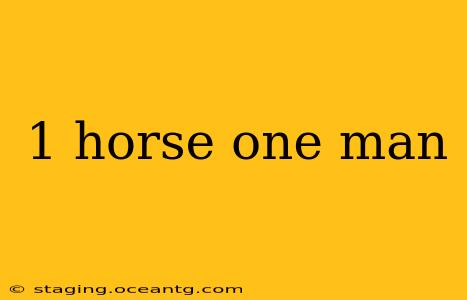One Horse, One Man: Exploring the Timeless Bond Between Rider and Steed
The image of one horse, one man, conjures a powerful sense of partnership, freedom, and enduring connection. This simple phrase evokes a rich tapestry of human history, encompassing everything from the practical necessities of transportation and work to the profound spiritual and emotional bond between humans and animals. Let's delve into the multifaceted aspects of this relationship, exploring its history, its modern relevance, and the enduring appeal of this iconic image.
What are the different types of relationships between a horse and a man?
The relationship between a horse and a man is remarkably diverse, shaped by the context and purpose of their interaction. At its most basic, it's a working relationship, as seen in agriculture, transportation, and even warfare throughout history. Farmers relied on horses for plowing fields, hauling goods, and countless other tasks. Soldiers rode horses into battle, their mounts integral to their survival and success. In these instances, the relationship is often functional, built on mutual reliance and training.
However, the bond can also be deeply personal and emotional. For many, horses represent companionship, freedom, and a connection to nature. Disciplines like dressage and competitive riding emphasize the intricate communication and understanding between horse and rider, fostering a partnership based on mutual respect and trust. Therapeutic riding programs demonstrate the powerful healing effects of this interaction, improving physical, emotional, and cognitive well-being. Ultimately, the relationship between a horse and a man spans a spectrum from pragmatic partnership to deep, intimate friendship.
How did the relationship between humans and horses evolve over time?
The relationship between humans and horses has evolved dramatically over millennia. Early interactions were likely characterized by hunting and a cautious distance. Domestication, believed to have begun in the Eurasian steppes around 4000 BC, marked a pivotal shift. This wasn't a sudden event but a gradual process of selective breeding and co-existence, resulting in horses becoming indispensable partners in human endeavors. Their strength, speed, and adaptability made them invaluable for transportation, agriculture, and warfare.
The advent of technology, particularly the internal combustion engine, led to a decline in the horse's role in transportation and agriculture. However, this didn't diminish the human-horse bond. Horses found new roles in leisure activities like riding, racing, and show jumping. The modern understanding of equine behavior and welfare has also shifted the focus towards ethical and compassionate treatment, reflecting a deeper appreciation for the horse as a sentient being.
What skills are needed to effectively work with a horse?
Working effectively with a horse demands a multifaceted skillset. Understanding equine behavior is paramount. Horses communicate through subtle body language, and mastering the ability to read these cues is crucial for building trust and preventing misunderstandings. Patience, consistency, and clear communication are essential, as horses thrive on routine and predictable interactions.
Practical skills like riding, grooming, and handling are also vital. Safety is always a priority, requiring a thorough understanding of equine anatomy and the potential hazards associated with working with large animals. Furthermore, developing empathy and sensitivity towards the horse's individual needs and temperament is key to establishing a strong, positive relationship. Ongoing learning and a commitment to continuous improvement are essential for any horse handler, regardless of their experience level.
What are the benefits of having a horse?
The benefits of having a horse extend far beyond the practical. For many, owning a horse provides a strong sense of responsibility, fostering discipline and commitment. The physical demands of caring for a horse contribute to a healthy and active lifestyle. The emotional connection forged with a horse can be incredibly rewarding, providing companionship, stress relief, and a deep sense of fulfillment.
Equine-assisted therapy further highlights the therapeutic benefits of human-horse interaction, helping individuals overcome physical and emotional challenges. Horses offer a unique blend of challenge and reward, requiring patience, dedication, and a willingness to learn and adapt. The journey of learning to understand and work with a horse can be a deeply enriching and transformative experience.
The image of one horse, one man, is a timeless symbol of partnership and resilience. It speaks to the enduring power of the human-animal bond and the profound impact this relationship has had on human history and continues to have on our lives today.
